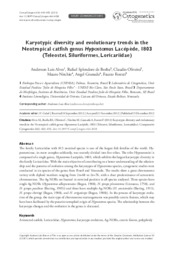Karyotypic diversity and evolutionary trends in the Neotropical catfish genus Hypostomus Lacépède, 1803 (Teleostei, Siluriformes, Loricariidae).
Karyotypic diversity and evolutionary trends in the Neotropical catfish genus Hypostomus Lacépède, 1803 (Teleostei, Siluriformes, Loricariidae).
Author(s): ALVES, A. L.; BORBA, R. S. de; OLIVEIRA, C.; NIRCHIO, M.; GRANADO, A.; FORESTI, F.
Summary: The family Loricariidae with 813 nominal species is one of the largest fish families of the world. Hypostominae, its more complex subfamily, was recently divided into five tribes. The tribe Hypostomini is composed of a single genus, Hypostomus Lacépède, 1803, which exhibits the largest karyotypic diversity in the family Loricariidae. With the main objective of contributing to a better understanding of the relationship and the patterns of evolution among the karyotypes of Hypostomus species, cytogenetic studies were conducted in six species of the genus from Brazil and Venezuela. The results show a great chromosome variety with diploid numbers ranging from 2n=68 to 2n=76, with a clear predominance of acrocentric chromosomes. The Ag-NORs are located in terminal position in all species analyzed. Three species have single Ag-NORs (Hypostomus albopunctatus (Regan, 1908), H. prope plecostomus (Linnaeus, 1758), and H. prope paulinus (Ihering, 1905)) and three have multiple Ag-NORs (H. ancistroides (Ihering, 1911), H. prope iheringi (Regan, 1908), and H. strigaticeps (Regan, 1908)). In the process of karyotype evolution of the group, the main type of chromosome rearrangements was possibly centric fissions, which may have been facilitated by the putative tetraploid origin of Hypostomus species. The relationship between the karyotype changes and the evolution in the genus is discussed.
Publication year: 2012
Types of publication: Journal article
Keywords: Cariotipo, Fish, Karyotyping, Loricariidae, Peixe, Polyploidy
Observation
Some of Embrapa's publications are published as ePub files. To read them, use or download one of the following free software options to your computer or mobile device. Android: Google Play Books; IOS: iBooks; Windows and Linux: Calibre.
Access other publications
Access the Agricultural Research Database (BDPA) to consult Embrapa's full library collection and records.
Visit Embrapa Bookstore to purchase books and other publications sold by Embrapa.

